Biography of Thomas Edison
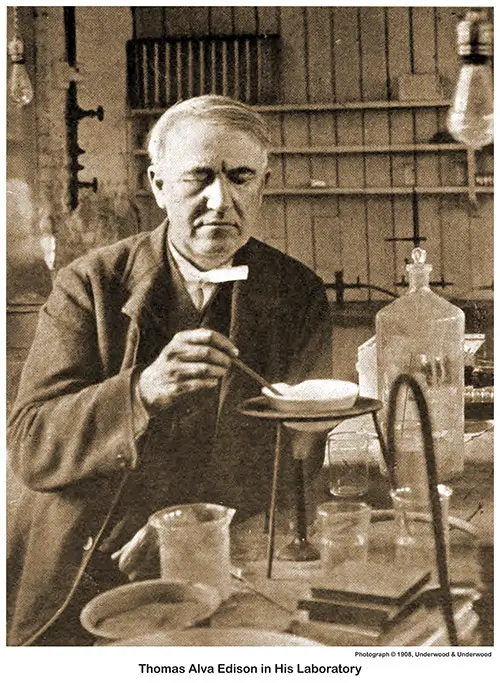
Thomas Alva Edison in His Laboratory. Photograph © 1908, Underwood & Underwood. Thomas Alva Edison, 1908, p. i. GGA Image ID # 1c3b04e66b
The Yearly Years
Often in America, the children of humble parents have become distinguished men. Some have gained respect by their wise management of public affairs; some are honored because they led our armies to victory; and some are admired by reason of the beautiful stories and poems which they have written.
A few men have earned the gratitude of the people by adding to the comfort and happiness of everyday life through their wonderful inventions.
Of these last, Thomas Alva Edison is one of the best-known examples. This great inventor may well be called a “self-made" man. His parents were humble people with only a few acquaintances and friends.
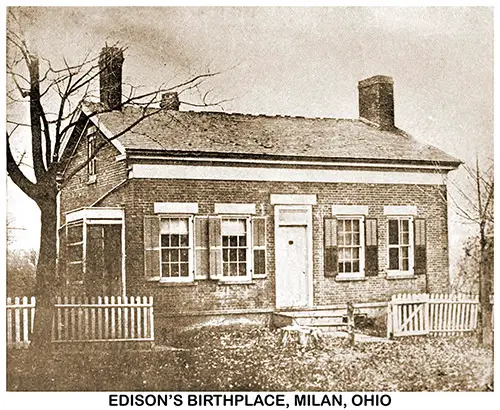
Edison's Birthplace, Milan, Ohio. Thomas Alva Edison, 1908, p. 4. GGA Image ID # 1c3b1619a3
The father was a hardy laboring man, who came from a family that worked hard and lived long. Mr. Edison made shingles with which to roof houses.
He made good shingles, too. At that time, this work was not done by machinery, but by hand. Mr. Edison employed several workmen to help him. He was industrious and thrifty.
When Thomas Edison was born, on the eleventh of February, eighteen forty-seven, the shingle- maker lived in Milan, a village in Erie county, Ohio. His home was a modest brick cottage on Choate Avenue. The house was built on a bluff overlooking the valley where the Huron River Bows, with the canal beside it.
In harvest time the little village was a busy place. All day huge farm wagons drawn by four or six horses rumbled along the dusty roads, carrying grain to the canal. For the farmers from far and near brought their grain to Milan to send it by canal to Lake Erie.
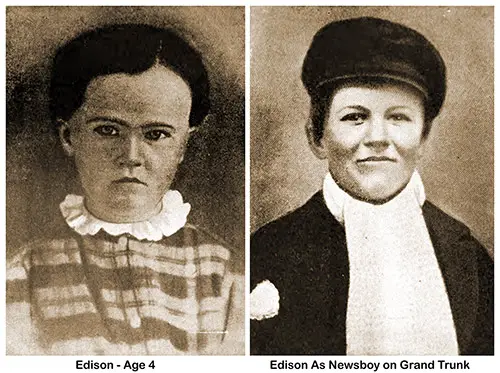
(Left) Young Edison at Age 4. (Right) Edison as a Newsboy on Grand Trunk Railroad. Thomas Alva Edison, 1908, p. 10. GGA Image ID #
Often as many as six hundred wagonloads of grain came to the village in a single day. The narrow canal was crowded with barges and sailing vessels, which were being loaded with it.
Little Thomas Edison was not content to watch this busy scene from his home on the hill. At a very early age he went with the older boys to have a closer view.
He soon learned to go about the village and when he was no older than many children who are never allowed outside of the nurse's sight, he trotted about alone and felt very much at his ease among the farmers and rough workmen.
Thomas was a serious looking child. He had a large head covered with a wayward shock of hair, which would not curl nor even part straight. He had a broad, smooth forehead, which was drawn into wrinkles when anything puzzled him. His big eyes looked out from beneath heavy brows with wonder in childhood with keenness when he grew older.
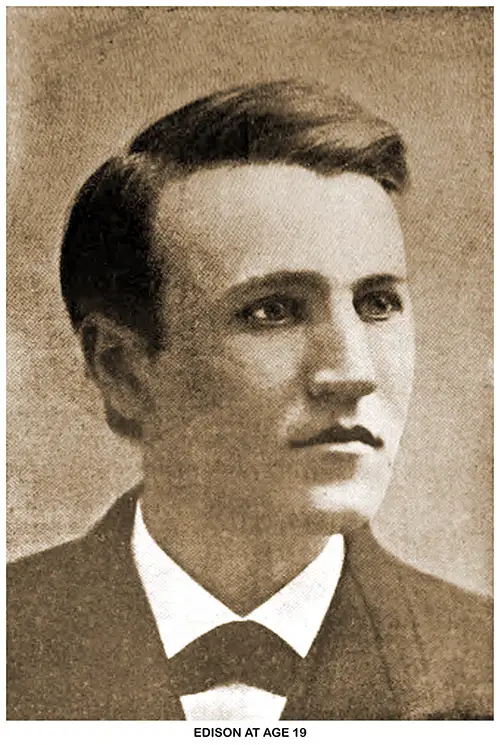
Edison at Age 19. Thomas Alva Edison, 1908, p. 40(a). GGA Image ID # 1c3b395a2e
Whenever his brow scowled, his thin lips were pressed tightly together. Even when the child smiled, his chin looked very square and firm. The strangers who noticed him said, not, “What a pretty child," but, “What a smart-looking boy!"
The father believed that the best thing he could do for his son was to train him to be industrious.
The mother had been a school teacher. She considered an education an important part of a boy's preparation for life. Both parents began early to do what seemed to them their duty towards their son. His father required him to use his hands. His mother taught him to use his head.
He was an eager pupil. An old man in Milan remembers seeing Edison, when he was a youngster in dresses, sitting upon the ground in front of a store, trying to copy the store sign on. a board with a piece of chalk. He went to school very little.
He could learn much faster at home, where he did not have to go through the formality of raising his hand every time he wanted to ask a question; he wanted to ask a great many.
When Edison was still a mere child, a railroad was built through Milan. Then the farmers used the railroad instead of the canal for shipping their grain. For that reason there was less business in Milan than before the road was built.
Many families that had done work in connection with the canal moved away. The place became so dull that Mr. Edison found it hard to make a living there.
Accordingly, when Thomas was seven years old, Mr. Edison moved his family to Port Huron, Michigan. Mr. Edison once said that his son had had no childhood.
We have seen that as a child, he was a little "sobersides," too busy getting acquainted with the world around him to care for play. As he grew older, his face lost its solemn look.
He became an active fun-loving boy. But he differed from other boys in that he found his “fun" In doing things which most boys would have called work.
Youthful Business Ventures
When Thomas, or Alva (he was called by his middle name during his boyhood) was twelve years of age, his father considered him old enough to earn his own living. He was therefore willing to have him take a position as train boy on the Grand Trunk Railroad.
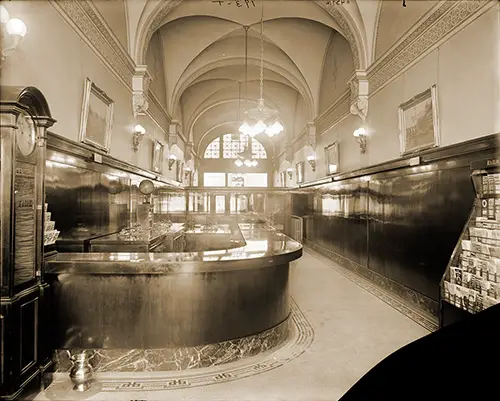
Grand Trunk Western Railroad Ticket Office Detroit Michigan - c1905. Library of Congress, LC 2016812806. GGA Image ID # 1c39d4fa40
Young Edison was just the person to enjoy a train boy's life. He was fitted to make a success of the business. Forward and self-confident, he had a pleasant, jovial manner, which made him popular with strangers. He. was quick-witted enough to say just the thing about his wares to amuse or interest the passengers. And he sold enough newspapers and sweetmeats to clear a good profit.
Besides, he was shrewd and self-reliant. Finding that the sale of papers depended on the news they contained, he looked them over carefully before buying, and soon learned to judge accurately the number he could sell.
The Civil War was then going on, and when there was exciting war news, papers were in great demand. One day he opened the paper and found an account of the battle of Pittsburg Landing. He said to himself, "I could see a thousand of these papers, if I had them, and if the people at the stations only knew there had been a battle." Here were two big "ifs," but the boy promptly made up his mind how to overcome them.
He went to the telegraph office and sent dispatches to the towns at which his train stopped, announcing that a terrible battle had been fought. He felt sure that the news would spread rapidly through the villages, and crowds would be at the stations waiting for the papers.
He then went to the newspaper office and asked the business manager to sell him one thousand copies of the Detroit Free Press, on credit. The manager refused curtly. Nothing daunted the boy sought the office of the editor, Mr. W. F. Story.
"I am the newsboy on the Grand Trunk Railroad, from Detroit to Port Huron, and I should like to have one thousand copies of to-day's 'Press,' containing the account of the battle," he said blandly.
"I have no money to pay for them, but I am sure I shall be able to pay you out of the proceeds of the day's sale."
The editor looked at him in surprise." And where do you expect to, find purchasers for so many papers?" he asked. When he heard what the youth had done to secure his customers, he smiled and gave him an order for the papers.
Edison· was not mistaken; he found his papers in such demand "that he was able to raise the price first to ten cents, then to twenty-five cents. He made what seemed to him a fortune out of the day's work.
Profit in money was not, however, all that Thomas Edison gained from his experience as train boy. The busy, varied life he led was in many ways an education to the active, wide-awake boy. While attending. to his work he gave it his undivided attention. But when he had finished it, he dismissed it from his mind and interested himself in other things.
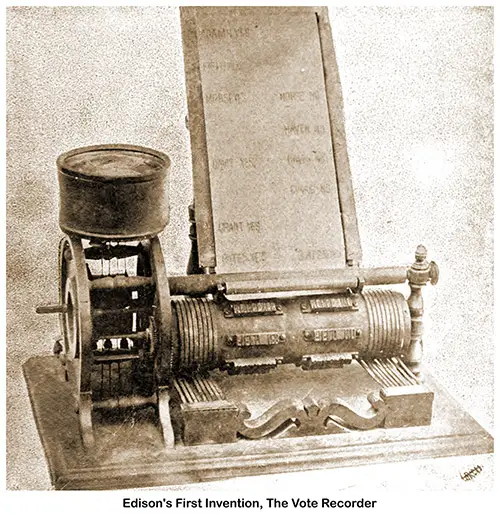
Edison's First Invention, the Vote Recorder. Thomas Alva Edison, 1908, p. 54. GGA Image ID # 1c3bbc3798
He learned a' good deal about the country through which he traveled every day. Most boys are thoroughly well acquainted with the one town in which they live, but he knew Detroit as well as Port Huron, and was familiar with the geography and business of the country and villages between those cities.
His train was a mixed train, made. up of freight and passenger cars. The newsboy considered himself a very important part of that train. He knew it from engine to caboose, and was on good terms with all the trainmen. Indeed, he felt an interest and pride not only in "my train," but in "my road, "as he called the Grand Trunk Railroad.
He knew its officers, its trainmen, its station agents, the telegraph operators, and even the trackmen. He could always be depended upon for the latest railroad news either in the nature of business or personal gossip.
Finding that others were as much interested as he in what was going on- along the road, but were slower in finding it out, he decided to print a railroad newspaper. He got some old type from the office of the ., Detroit Free Press" where he had made friends, and set up a printing office in the corner of a freight car.
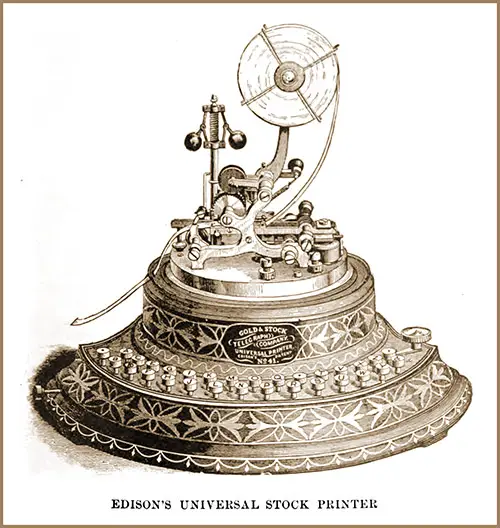
Edison's Universal Stock Printer. Thomas Alva Edison, 1908, p. 64. GGA Image ID # 1c3bc4f956
One-half of the car was fitted up as a smoker, and the newsboy took possession of the unused half. There, when he had nothing else to do. he worked hard on a paper of which he was proprietor, editor, business manager, reporter, and printer.
He issued his paper weekly and called it "The Grand Trunk Herald." It was a small paper consisting of two sheets printed on one side only. It was poorly printed, and the grammar and punctuation were often faulty, but it contained much that was of interest to those who were connected with the railroad.
Besides such business items as changes in time, the connections made with the train by stagecoaches, and announcements of articles lost and found, it was filled with current railroad news and observations by the editor, which give us a good idea of the character and habits of the boy. Here are some extracts from the "Herald:"
"Heavy shipments at Baltimore; we were delayed the other day at New Baltimore Station, waiting for a friend, and while waiting took upon ourselves to have a peep.at things generally; we saw in the freight house of the G. T. R. 400 barrels of flour and 150 hogs waiting for shipment to Port Lana."
" John Robinson, baggage master at James Creek Station, fell off the platform yesterday and hurt his leg. The boys are 'sorry for John."
"No. 3 Burlington engine has gone into the shed for repairs."
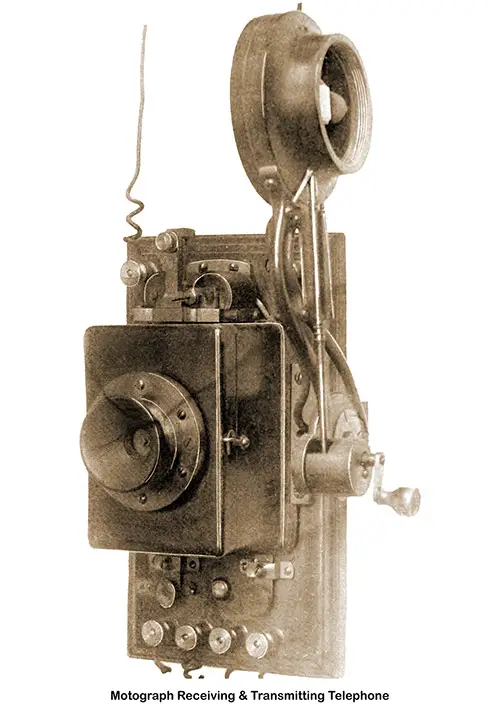
Motograph Receiving & Transmitting Telephone. Cassier's Magazine, February 1893, p. 296. | GGA Image ID #
"The more to do the more done. We have observed along the line of railway at the different stations where there is only one Porter, such as at Utica, where he is fully engaged from morning until late at night, that he has everything clean and in first-class order, even on the platforms the snow does not lie for a week after it has fallen, but is swept off before it is almost down, at other stations, where there is two Porters, things are vice-versa."
"Premiums. We believe that the Grand Trunk Railway give premiums every six months to their engineers who use the least wood and oil running the usual journey. Now we have rode with Mr. E. L. Northrop, one of their engineers, and we do not believe you could fall in with another engineer more careful or attentive to his engine, being the most steady driver that we have ever rode behind [and we consider ourselves some judge having been railway riding for over two years constantly ] always kind and obliging and ever at his post. His engine we contend does not cost one fourth for repairs what the other engines do. We would respectfully recommend him to the kindest consideration of the G. T. R. officers."
The good-natured self-importance of the young editor, with his pompous editorial "We," is amusing. But though the reader may smile at the fourteen-year-old boy's recommendation of the experienced engineer to the attention of the railroad officer, he feels that the writer must have been a sensible boy and that he knew what he was talking about. Edison's remarks about the well-kept station house show the boy's appreciation of order and punctual attention to duty. What he has to say is sensible and sincere, and it is not surprising that he found readers.
He had over three hundred subscribers for his paper, at three cents a copy. Of course the readers of the "Herald" were all railroad men.
This little sheet gained some notoriety, however, and was mentioned in a London paper as the only newspaper in the world published on a train.
Edison's success with the “Herald” induced him to undertake to print a paper of more general interest. His second paper was called" Paul Pry." In this paper, Edison used great freedom in expressing opinions of men and things. On one occasion, a personal paragraph in his paper so angered a reader, that, seeing the editor near the river, he gave him a good ducking. This severe punishment dampened the youthful editor's enthusiasm for journalism, and he gave up the business a short time after the occurrence.
Self-Taught Education
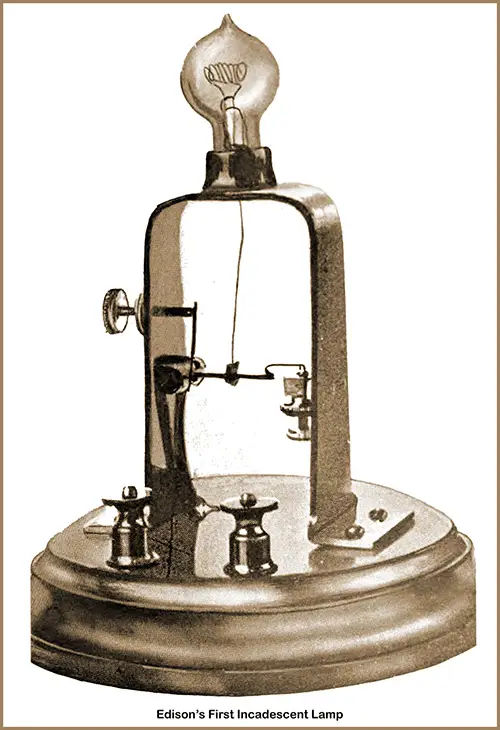
Edison's First Incandescent Lamp. In a suit against the Boston Incandescent Lamp Company et al., in the United States Circuit Court for the District of Massachusetts, decided in favor of Edison on June n, 1894, Judge Colt, in his opinion, said, among other things: "Edison made an important invention; he produced the first practical incandescent electric lamp; the patent is a pioneer in the sense of the patent law; one may say that his invention created the art of incandescent electric lighting." Thomas Alva Edison, 1908, p. 106. GGA Image ID # 1c3c348d81
A boy who writes his ideas for others to read is pretty sure to be interested in reading what others have written. This was the case with Edison. He realized that there was a good deal in books that was worth knowing. He had no one to guide him in selecting his 'reading, but that did not trouble him. Life seemed long, and books were very little things. There was surely time enough for an industrious person to read them all. He determined to begin with the Free Library of Detroit.
He picked out a shelf of particularly large, wise-looking books and commenced reading. Among these books were Gibbon's "Decline and Fall of the Roman Empire," Hume's "History of England," Burton's "Anatomy of Melancholy," and Newton's "Principia."
A large part of the contents of these books was too advanced for the understanding of the young reader ... Nevertheless he kept cheerfully at the task he had set himself, until he had finished all the books on a shelf fifteen feet long.
He had learned a great many interesting facts from this difficult reading. But perhaps the most valuable lessons the experience taught him were about books. He had discovered for himself that it was both impossible and undesirable to read all books; that some had in them very little that was of value to him, and were not worth the time it took to read them, while others deserved the closest study.
In fact, he had become something of a critic, and was able to judge for himself whether a book would interest and help him. He did not stop reading when he had finished the shelf, but henceforth he chose his books with more care.
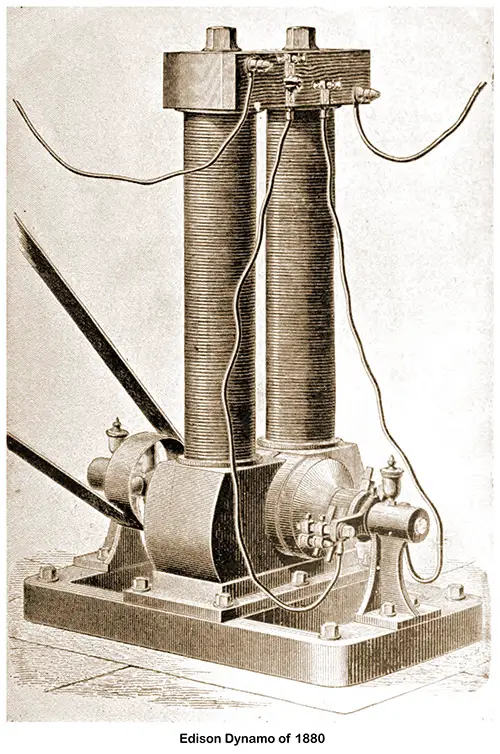
Edison "Z" Pattern Dynamo of 1880. There Are Several Forms of Edison Dynamo Having Drum Armatures Rotating Between Heavy Iron Pole Pieces. The "Z" Machine, Shown Above, Was Capable of Working Sixty Edison Lamps. Thomas Alva Edison, 1908, p. 116. GGA Image ID # 1c3ca5fd21
Some of the books that he read troubled him, because he could not wholly understand them, and he was always on the lookout for someone who knew enough to explain the difficulties to him. Other books filled his mind with new ideas and made him think very hard.
An old chemistry excited him so much that he could think of nothing but the wonderful statements it contained about even such simple things as air, water, fire. He was curious to experiment with some of the strange elements mentioned in it, such as oxygen, nitrogen, and hydrogen.
Thomas Edison was not the boy to sit still and wonder when his curiosity was aroused. He thought it would be a fine thing to have a workroom or laboratory, all fitted out with materials and implements for making chemical experiments, and he determined to have one.
His first step towards the realization of this ambition was to get acquainted with a chemist. The next, was to buy such second-hand apparatus as he could with the money he had saved, and get a few of the cheaper chemicals. These he arranged neatly in the corner of the freight car which was his newspaper office.
The little bottles with their glass stopples and mysterious contents were exceedingly precious to him, and lest someone should meddle with them, he pasted poison labels on all of them.
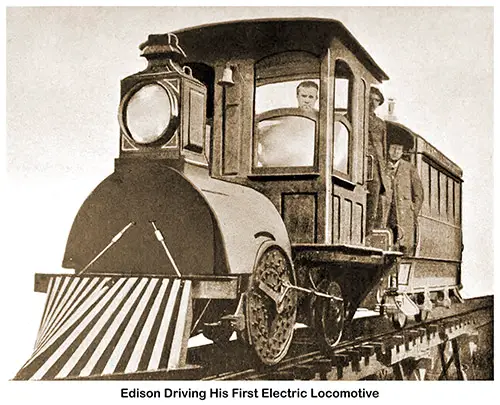
Edison Driving His First Electric Locomotive. The Electric Locomotive and Passenger Car. Popularly Known as the "Pullman," It Constituted Part of the Train of Cars Employed on Mr. Edison's First Electric Railway, Operated at Menlo Park. New Jersey, in 1880 and 1881. Thomas Alva Edison, 1908, p. 124. GGA Image ID # 1c3cae7675
In his crude little laboratory, the inventor made his first experiments. He found this a very fascinating pastime. He was willing to work hard, dress poorly, and eat plain food for the sake of his laboratory. Without a teacher, with only a book to instruct him, he experimented until he had learned, the properties and powers of many chemical substances.
He had accidents occasionally, for although he was careful, he worked under disadvantages on the jolting train. One day a bottle of phosphorus fell from its shelf and broke. The contents set the floor on fire. The fire was put out before it had done much injury; hut the conductor was excited and angry. He said he would have no more of the dangerous stuff on his train.
To be very sure that he would not, he threw the remaining bottles out of the car, and hurled after them not only all of the laboratory furnishings, but even the printing press. The owner protested with some spirit against the destruction of his property, whereupon the conductor seized him and pushed him out of the car.
Edison had learned in his rough-and-tumble life not to cry over spilt milk. It was discouraging to see the possessions he had collected with so much pains scattered by the roadside. But as soon as he had his fists unclenched the plucky fellow was ready to forgive the hasty conductor.
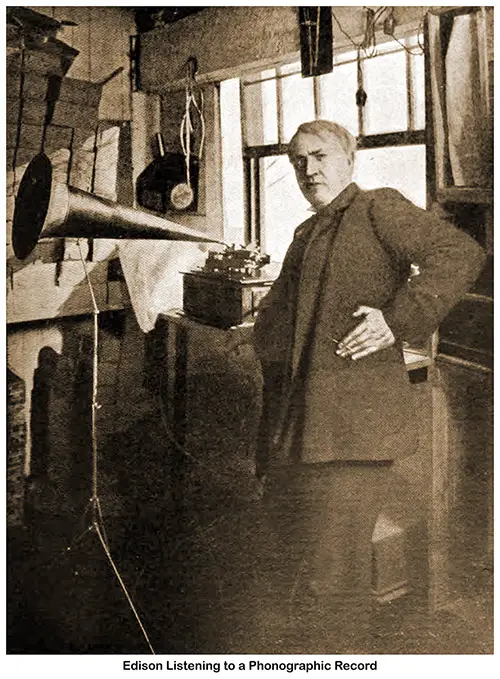
Edison Listening to a Phonograph Record. The Uses Made of the Phonograph up to This Time Have Been of Four Kinds, Generally Speaking—First, and Principally, for Amusement; Second, for Instruction in Languages; Third, for Business, in the Dictation of Correspondence; And Fourth, for Sentimental Reasons in Preserving the Voices of Friends. Thomas Alva Edison, 1908, p. 142. GGA Image ID # 1c3cbea13a
The old chap got a bad scare," he said to himself. "After all it's a wonder he didn't throw my traps overboard long ago." And he went to work picking up what was left of his printing shop and laboratory, planning the while where he would re-open his shop. He decided that his father's cellar would be the safest place. Before many days, he had made good his loss by new purchases and had begun work on a larger scale than ever.
A Change of Business - Telegraph Operator
Edison took up his train duties promptly, without any evidence of ill feeling towards the conductor who had treated him so harshly. A few weeks after that unpleasant occurrence, the train stopped one morning at Mount Clemens, to take on some freight cars, which were waiting on the sidetrack.
As usual, the train boy, with his papers under his arm, was peering about the station house to see what was going on. Suddenly, as he looked around the corner, he saw the two-year-old son of the station agent, playing on the track, while the heavy freight car that was being backed down to the train, was almost upon him.
Without a second's hesitation, the newsboy threw his papers to the ground and plunged forward to save the child. With one flying leap he seized the boy and cleared the track, falling on the gravel beyond, just out of' reach of the wheels of the car. The baggage-master, who saw the act and thought that both boys would be killed, gave a shriek, which brought everyone around the station to the spot.
When the child's father heard the story, he felt so grateful to the brave boy that he would have been glad to give him a rich reward. He was a poor man, however, and could not express his thanks in money.
But there was one thing he could do, to better the boy's fortune. He was a good telegraph operator; he would teach young Edison telegraphing, and get him a position where he could earn twenty-five dollars a month. Taking the boy's hand, he said, "You have saved jimmy's life, Al. and I'd like to show you how I feel about it. I haven't anything to give you, but if you'll stop off here two or three nights in the week I'll teach you to telegraph and get you a good job."
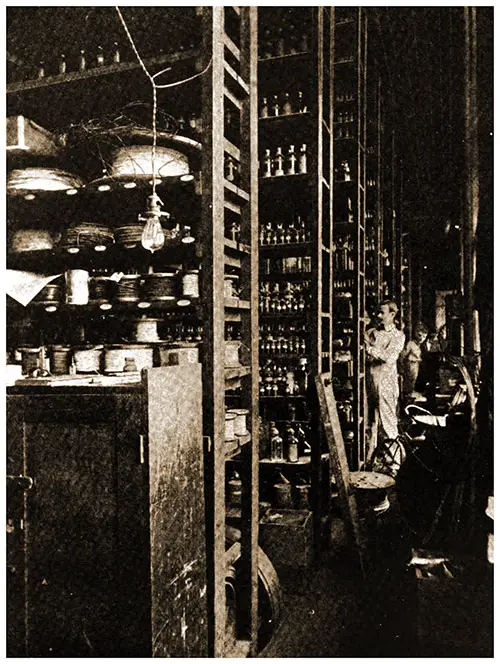
Stock room, Building 5. "The Shelves of Edison's Laboratory Are Said to Contain Samples of Every Known Substance." Windsor Magazine, November 1902. GGA Image ID # 1c3feba374
Edison's face lighted up with pleasure. "I don't want any pay for pulling Jimmy out from under that freight car," he said loftily. "But I would like mighty well to learn to telegraph. Nothing better! If it suits you we'll begin to-night."
The lessons were commenced at once and Mr. Mackenzie, the agent, found his work as instructor really pleasant at first. His pupil came regularly and made such surprising progress that it was a great satisfaction to teach him. But after a few days the train passed and "AI" did not get off.
This happened several days in succession. Mr. Mackenzie felt disappointed. "I declare he's like all the rest of them," he mused. I thought he had some grit. But I've always noticed that when a boy is so quick and learns so fast, he never keeps at it." He was mistaken, however, that time.
That very evening when the train came in, young Edison swung himself off with a beaming face. He carried a small package neatly tied up" which he was eager to show his friend. It proved to be a tiny telegraph instrument, which he had made at a gunsmith's shop in Detroit. It was so small that it could be placed on a small envelope, yet it was perfectly complete, and worked well when tested.
The young student in telegraphy had not lost interest, but he had come to a place where he could get along without a regular teacher. He was used to doing things in his own way and at his own time, and having received a good start from Mr. Mackenzie, was able to go on without much further help from him. He had made friends with many of the telegraph operators along the railroad. He now visited their offices to practice his art. He found them all interested in his progress and ready to give him a word of advice when he needed it. In three months' time he had so thoroughly mastered the business that Mr. Mackenzie said the boy knew enough to teach him.
He was not satisfied with being able to work the instrument, to send and receive messages. His inquiring mind wanted to discover how the instrument worked and why. He immediately began to experiment with electricity in his cellar laboratory.
With the help of a friend he constructed a short telegraph line of his own.· At first he tried to obtain a current from a very curious dynamo. He had noticed the sparks that may be produced by stroking a cat. Half in fun, and half in earnest, he got two large black cats and tried with much rubbing to create an electrical current, but was obliged to resort to the ordinary battery.
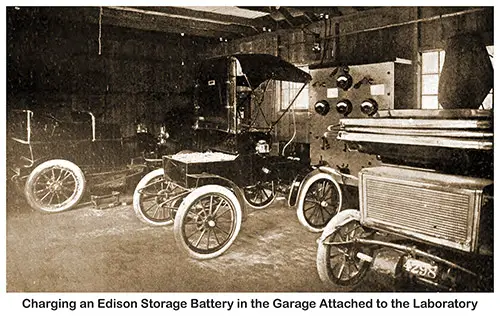
Charging an Edison Storage Battery in the Garage Attached to the Laboratory. An Edison Battery Will Retain Over Half Its Charge at the End of Six Months or More of Idleness. The Battery May Stand Indefinitely in Any State of Discharge Without Damage. The Battery Suffers No Damage From Temperatures as Low as 40° F. Below Zero, and May Be Charged to Full-Strength at Any Rate of Charge Without Injury to the Battery. Thomas Alva Edison, 1908, p. 214. GGA Image ID #
Edison gave up his position as train boy and spent most of his time at the Western Union Telegraph office in Port Huron. When there was more work to do than usual, or when one of the regular operators was not at his post, Edison was hired to' work for a short time. He did good work and was soon given a regular position at a salary of twenty-five dollars a month, with the promise of additional pay for extra work.
The Boy Telegraph Operator
Edison worked faithfully in his new position. He did extra work and did it well. But he waited in vain for the extra pay that had been promised him for taking long reports and working out of hours.
When he found that the man who employed him did not keep his word, he gave up his position. Mr. Mackenzie soon got him a situation as night operator at Stratford, in Canada.
So far as ability to send and receive messages went, Edison was perfectly capable of filling the place. But he was by no means the slow, faithful, unquestioning, obedient agent to leave in charge of a telegraph office at night.
He was a mere boy, only fifteen years of age; and had had no training in working under orders. He could not obey regulations, which seemed to him useless, and he sometimes thought he could improve on the directions given him.
There was no danger of his neglecting his duty through idleness, but he might neglect it while working out some pet notion of his own.
The manager of the circuit realized that the night operators might be tempted to shirk their work, and so he required them to telegraph a signal to him every half hour in order that he might be sure they were awake and at their posts. Edison's signal was six.
This was a wise regulation, but Edison did not appreciate the necessity for it. He found it a great bother to keep his eye on the clock and leave his reading or some experiment that he was working out in the quiet hours of night, to report that stupid "six" every thirty minutes.
He wondered if he couldn't make a machine attached to the clock that would save him the trouble. After a good deal of thinking and experimenting, he fitted up an instrument that could telegraph "six" as well as he could.
This was a great relief to him, and he felt free to do what he liked with his time without much fear of discovery. He even left the office and made expeditions about town.
One night while he was away, the manager tried to call him up but could get no response. He thought this odd as Edison was more punctual with his signals than any other operator on the line.
He waited, and tried again and again, with no better success, though the signals came with their accustomed regularity. He made an investigation, and the young inventor received a severe reprimand for his cleaver contrivance.
His next offense came near having serious results. He had orders to deliver messages to trains before reporting them back to the dispatcher. One evening, because it seemed easier to do so, he reversed the order and returned the message before delivering it.
Then he heard the engine bell ring for the train to start. He jumped up in a hurry, but when he got to the platform, the train was well in motion. The message was an order for the train to wait at the switch until a special had passed. He ran frantically after the train hoping he might catch it at the freight depot, but he could not overtake it.
He ran swiftly back to telegraph his error to the 'dispatcher, only to learn that it was too late to warn the other train. Now because of his disobedience two great trains were rushing towards each other on the same track.
That was a terrible hour for the poor boy. There were chances that the engineers would see each other's engines in time to prevent a wreck; but there were chances that they would not. It was frightful to think of the misery and loss he might be responsible for.
The watchfulness of the engineers prevented a collision. When the special came thundering up the track safe and sound, Edison knew that the danger was over. His disobedience had brought no harm to others. but he felt sure that he would hear more of it.
Nor was he mistaken. The superintendent called him to his office and frightened him with threats of imprisonment. He left town on the next train without even collecting the money due him for his services.
His experience at Stratford had been unfortunate perhaps, but he was a better operator because of it. He had not only gained in skill, but had learned the importance of obedience in little things.
He spent a few weeks at home out of work. One day when he was down by the St. Clair river, watching the ice which was breaking and piling up across the stream, word came that the electric cable between Port Huron and Sarnia, the Canadian city on the' opposite side of the river, had been broken by the ice jam.
There was no bridge; the ferryboat could not run on the ice-blocked river; with the cable broken all communication between the places was stopped. Edison saw a locomotive standing on a track nearby, and a thought struck him.
He jumped aboard her and whistled a greeting to Sarnia, making short toots for the dots and long toots for the dashes. He repeated his message several times.
At last, the trained ear of the old operator in Sarnia recognized the familiar signals of the Morse alphabet, and with the help of an engine whistle, sent a reply across the impassable river.
This little incident was very much talked about. People began to say that Thomas Edison was most ingenious.
Good telegraph operators were hard to get, and Edison was not long without a position.
Telegrapher and Inventor
Edison was not a dreamer. He may have had vague notions of doing something great in the distant future, but they did not interfere with the accomplishment of his practical, definite ideas.
Having become a telegraph operator, his modest ambition was to be a good one. More than that, he wanted to be able to receive "press reports." That is, he wanted to be able to work so fast that he could handle the long dispatches sent to the newspapers.
That was not an easy task. Indeed for a while he gave up hope of being able to keep up with the clickings of an expert sender, without the help of some mechanical device. If he could only find a way to make those confusing dots and dashes come more slowly!
His busy brain and nimble fingers working together, soon discovered a way to do this. He contrived a repeating receiver, which recorded the message as rapidly as the best sender could send it, and repeated it as slowly as the poorest receiver could wish.
When this repeater was in working order, Edison secured an engagement to take some pressreport work. He told the sender to "rush" him. The man did so, but no matter how rapidly he worked, he did not seem to be able to confuse the marvelous receiver.
Edison was meanwhile copying slowly from his faithful repeater. He was able in this way to hand in beautifully written, unscratcned, and unblotted sheets of report, which aroused the astonishment and admiration of all who saw them.
Soon, however, a report came in that had to be delivered immediately. Then the inventor was in difficulty. and had to admit that he was not such a fast receiver as he seemed.
To invent the repeater, required a higher order of mind perhaps, than was necessary to receive messages rapidly. But Edison felt no pride in that achievement. His object was to be a rapid receiver and nothing else would satisfy him.
He next made a series of thorough experiments in penmanship, to discover which was the most rapid style of writing. After a long and careful examination he· decided on the clear, round, upright characters which he used all the rest of his life.
It is interesting to notice that this youth was about thirty years ahead of the writ!ng teachers in adopting the beautiful vertical writing, which is taught in many schools today.
Obliged to give up press-report work until he had gained greater skill, Edison devoted his time to practicing as the only means of acquiring the . speed he desired.
He worked all day and, whenever he could get employment, all night, snatching , bits of sleep when he could. His constant diligence soon enabled him to work so fast that he was put at one end of a line worked by a Louisville operator, who was one of the fastest senders in the country. His experience at that wire made him as expert as even he desired to be.
But he was not ready to sit down to rest. As soon as one thing became easy for Edison he always began working on something else.
While at Memphis, he constructed an instrument called an automatic repeater, which made it possible to connect separate telegraph lines in such a way as to transfer messages from one wire to the other without the aid of an operator.
He then began to try to discover how two messages might be sent over the same wire at the same time. He spent a large part of his time reading and experimenting with this end in view.
His fellow operators laughed at him and called him the "luny," because he had so many "queer notions" and did not care for the things they enjoyecd. He worked constantly, dressed shabbily, and spent most of his money for scientific books and materials with which to make experiments.
His gay comrades liked him in spite of his peculiarities. He was ready with jokes, and funny stories, and could be depended on to lend an empty-pocketed friend a dollar in the days of scarcity which usually preceded pay day.
His employers were often impatient with him. They thought it strange that a young man who could telegraph so well, was not content to do it, but must needs neglect his work, while he wasted time and kept the office in confusion with some impossible scheme.
This is the reason that for five years Edison roamed from town to town, through the central states, never having much trouble to get a place because he was such a good operator, and never keeping one long because he could not overcome his impulse to invent.
During those five years he suffered a good many hardships and formed very irregular habits of work, often studying and working all night long. But while. many of his comrades fell into evil ways, Edison lived a clean, straight life. This was one reason why he was able to work so hard without injuring his health.
Heading East To Boston
Edison had a friend in Boston. This man urged him to come east. He said that he would receive a better salary and have greater opportunities for study and invention.
When a vacancy occurred in the Boston office, he recommended Edison for the place. And so it happened that when Edison was twenty-one years old, he was called to the great city of Boston.
Here is the account the inventor himself gives of his first appearance in the Boston telegraph office:
"I had been four days and nights on the road, and, having had very little sleep, did not present a very fresh or stylish appearance, especially as compared to the operators of the East, who were far more dressy than their brethren of the West. The manager asked me when I was ready to go to work. "
'Now,' I replied. I was then told to return at 5:50 P. M., and punctually at that hour I entered the main operating rooms, and was introduced to the night manager. My peculiar appearance caused much mirth, and, as I afterwards learnt, the night operators consulted together how they might 'put a job on the jay from the woolly West. ' I was given a pen and assigned the New York No. I wire."
" After waiting upwards of one hour I was told to come over to a special table, and take a special report for the Boston Herald, the conspirators having arranged to have one of the fastest senders in New York to send the dispatch and 'salt' the new man. I sat down unsuspiciously at the table and the New York man started slowly."
"I had long since perfected myself in a simple and rapid style of handwriting, devoid of flourishes, and susceptible of being increased from forty-five to fifty-four words a minute by gradually reducing the size of the lettering. This was several words faster than any other operator in the United States."
"Soon the N ew York man increased his speed, to which I easily adapted my pace. This put my rival on his mettle, and he put on his best powers, which, however, were soon reached. At this point I happened to look up, and saw the operators all looking over my shoulder, with their faces shining with fun and excitement I knew then that they were trying to put a job on me, but kept my own counsel and went on placidly with my work, even sharpening a pencil at intervals, by way of extra aggravation.
"The New York man then commenced to slur over his words, running them together, and sticking the signals; but I had been used to this style of telegraphy in taking reports and was not in the least discomfited. Finally when I thought the fun had gone far enough, and having about completed the special, I quietly opened the key and remarked, 'Say, young man, change off, and send with your other foot.' This broke the New York man all up, and he turned the job over to another man to finish."
Men are usually ready to respect real merit. Edison's fellow-workers, on discovering his ability, gave the new comer a cordial welcome among them, in spite of his careless dress.
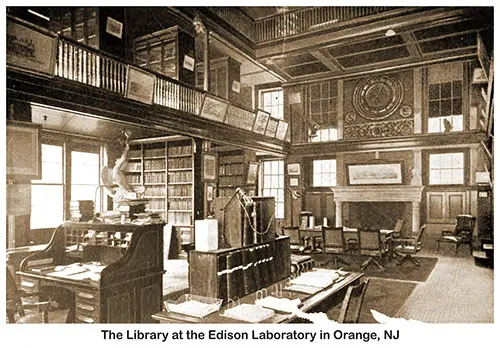
The Library at the Edison Laboratory in Orange, NJ. The Library was located in Building 5. Chairs were equipped with telephone receivers, for transcontinental telephone conversation with Edison.
But better even than that, Edison found his new employer to be a man of high intelligence. He could talk over his ideas with him without fear of being called a "luny." It was a new pleasure to the young man to find sympathy and appreciation concerning the questions that were of the highest interest to him.
The Boston Public Library furnished him with valuable works, which he had not been able to obtain in the West. He met men of scientific learning and came in contact with highly skil1ed artisans.
Everything in his new life stimulated his ambition and encouraged him to attempt great things. Much of the time he felt as he expressed it one morning to a friend: "I've got so much to do and life is so short, I'm going to hustle."
His regular work occupied the night hours. That left the day free. He spent as few as possible of the precious hours in sleep. Having found that he could not carryon his experiments in the telegraph office here, as he had so often done in the West, he opened a small shop of his own.
In that shop he spent a large part of each day. Sometimes he devoted all of his time to working on his own inventions. Again, he took orders and did work for others.
He became known in Boston as an authority on electricity, and was even invited to speak on the subject before a school of young women.
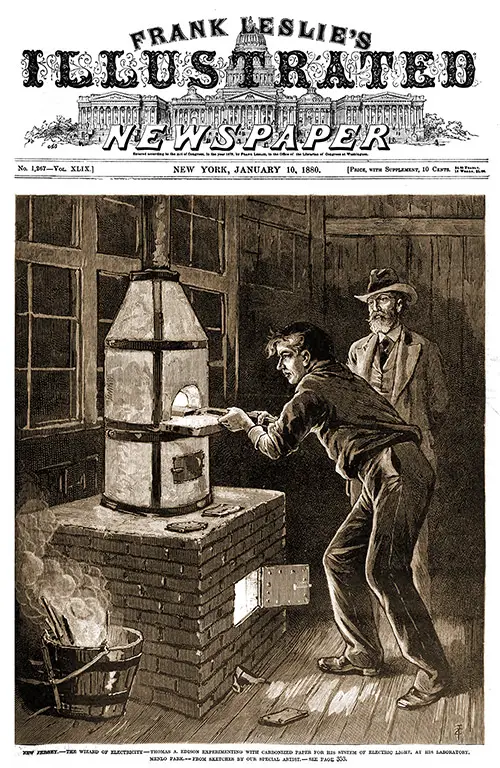
Thomas A. Edison Experimenting With Carbonized Paper for His System of Electric Light, at His Laboratory, in Menlo Park, NJ. Frank Leslie's Illustrated Newspaper, 10 January 1880, p. 311. GGA Image ID # 1c3a6d6626
He was especially interested at' this time in inventing an electrical instrument for recording votes in a great assembly like the House of Representatives. He made an excellent machine that did its work faultlessly, and had it patented.
After all his labor and expense he found that legislative bodies did not care for such an accurate and speedy vote recorder. His invention was useless. This was a bitter disappointment to him and he did not forget the lesson it taught him: never invent anything without first finding out whether it is needed.
Having failed with his vote recorder because of his ignorance of parliamentary customs, he returned to the familiar field of telegraphy and once more tried to solve the problem of sending two messages over a wire at one time. There was no doubt that a contrivance, which would make that possible, would be in demand.
He progressed so well with his experiments that in 1869 he was ready to make a trial of his invention on a large scale.
At this time his engagement with the Western Union Telegraph Company being completed, he resolved to go to New York.
New York Inventor and Electrician
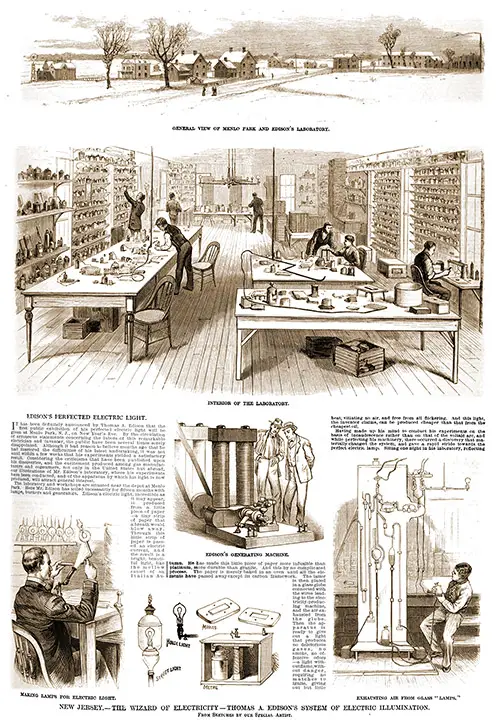
New Jersey -- The Wizard of Electricity -- Thomas A. Edison's System of Electric Illumination. (Top) General View of Menlo Park and Edison's Laboratory. (Center) Interior of the Laboratory. (Lower Center) Edison's Generating Machine. (Bottom Left) Making Lamps for Electric Light. (Bottom Center) Meter Box, Street Light, House Light, Molds. (Bottom Right) Exhausting Air From Glass "Lamps." Frank Leslie's Illustrated Newspaper, 10 January 1880, p. 353. GGA Image ID # 1c3a2766ae
Edison's stay in Boston had been pleasant and profitable in many ways, but he felt more and more that New York, the great center of the American business world, was the city of opportunity.
He arrived there with no work and no money. For although he had been a hard worker while in Boston, he had spent so much on experiments and inventions that he was heavily in debt.
He did not feel worried for the future however. He had the greatest confidence in himself and in electricity. He knew that electricity could be made to do marvelous things and that few men knew so well as he how to make it do them.
Failing to get employment in a telegraph office as he had hoped to do, he wandered about, visiting the various establishments maintained in connection with electrical enterprises, in the hope of finding some work.
One day as he approached the office of Laws' Gold Reporting Telegraph Company, he noticed an excited crowd of men and messenger boys around the entrance.
Coming nearer, he learned that there was something wrong with the electrical instrument, which sent the market reports to the brokers' offices and that if it was not remedied at once, many businessmen would lose heavily.
He made his way quietly and quickly into the office where he found Mr. Laws almost distracted with anxiety. The apparatus refused to work, and he was so nervous and excited that he could not find what the trouble was. Edison went up, and introducing himself as an electrician, made a rapid but careful investigation.
He had been working on an invention somewhat similar and understood the instrument perfectly. He discovered the difficulty and corrected it while Mr. Laws looked on in admiration.
His sure, swift movements showed his familiarity with the complicated and delicate mechanism.
This performance won the respect of Mr. Laws as completely as the rapid telegraphing had secured the esteem of the Boston operators. Mr. Laws not only felt grateful, but he immediately recognized in Edison a man whose services were worth having. This incident led to Edison's obtaining regular employment under Mr. Laws at a salary of three hundred dollars a month.
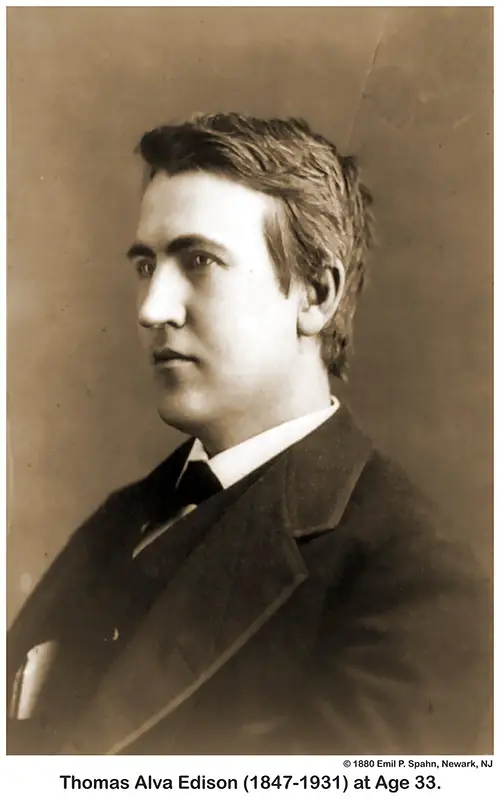
Thomas Alva Edison (1847-1931) at Age 33. Photograph © 1880 Emil P. Spahn, Newark, NJ. Library of Congress LC 89714703. GGA Image ID # 1c39f40e5b
Having accomplished his boyish ambition to be an expert telegraph operator, Edison, at the age of twenty-two gave up that business and started out in a broader field of work.
He began at once to make improvements in the machine used by the company he served. Before long he invented a new and better instrument to take its place.
His next important step was to enter the service of the Gold and Stock Telegraph Company. Edison made numerous inventions in connection with the apparatus used by this company. The company considered them so valuable that it offered to buy them all.
When the committee representing the company asked Edison how much he would take for his inventions he replied that he did not know what they were worth. He asked what the company was willing to give him. He had decided to accept if offered five thousand dollars. Imagine his surprise when offered forty thousand dollars.
The young man was not long in deciding how to spend his unexpectedly acquired fortune. With it he equipped a larger and more elaborate shop than he had ever had.
He now had room, implements, and assistants for working out the schemes, which had been simmering in his head, ever since he was a boy.
He accomplished so much that he began to be looked upon as a wonder. The Western Union Telegraph Company and the Gold and Stock Telegraph Company feared that rival companies would obtain the use of his patents.
So they paid him a large salary to give them the option on all of his telegraphic inventions. This made it possible for Edison to devote his entire time to the work he loved: to making machines, which would do well, the work which existing machines did poorly.
Inventor and Manufacturer
Edison opened a large laboratory and factory in Newark, New Jersey. There he employed three hundred men to assist him in his experiments and to make the contrivances, which he invented.
This was a more serious responsibility than he had yet undertaken. It was one thing to tinker away by himself and work out his ideas with his own skillful hands, and quite another to manage and direct three hundred men.
He was not, however, ignorant of human nature. Even when a newsboy he had been busy getting acquainted with people and learning to influence them so they would do as he wished.
In his factory, his manner toward his men was friendly and boyishly unconstrained.
There was little formality between employer and employees; his men were not afraid of the "boss." He depended on their interest and good will, rather than obedience to rigid rules, for the best results.
His big factory was managed with a surprising lack of regularity. If he was anxious to have a piece of work finished, all hands were kept over hours. When things went well and some important undertaking was completed, there was a fragment of a holiday.
It is said that when a man asked Edison to what he owed his success, he replied, "To never looking at the clock." He expected from his men something of the same indifference to time and absorption in work that he had always shown.
On one occasion, when an instrument did not give satisfaction and he could not find what was wrong, he took half a dozen of his most able assistants with him to an upper room, saying, "We will stay there until this thing is straightened out." They worked there sixty hours, and at the end of that time came out of their voluntary prison tired, but satisfied and successful.
If Edison demanded a good deal of his men, he was more severe with himself. Many and many a time, after a day's work, he sat all night in his private office or laboratory studying out some baffling problem.
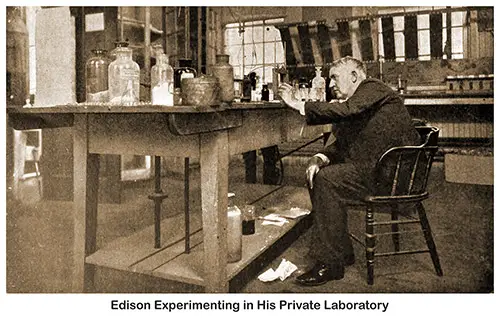
Edison Experimenting in His Private Laboratory. Thomas Alva Edison, 1908, p. 184. GGA Image ID # 1c3d526af8
He was very much beloved by his workmen, and if he came back from a business trip to New York, with his boyish face all aglow with satisfaction, and tossed his silk hat up to the ceiling with a cheer for the invention he had just sold, a wave of good feeling and hilarity spread over the whole establishment.
It was in the first year of his life at Newark that Edison married. After a brief and business-like courtship, he married Miss Mary Stillwell, a young woman employed in· his factory. He carried his enthusiasm for electricity even into his home and nicknamed his first two children "Dot" and "Dash," from the signals of the telegraph.
In money matters, Edison was as reckless as in his expense of time. He employed no bookkeeper, and paid his bills with notes. He rarely knew whether he was in debt or had a surplus on hand. In his view, money was merely a means for carrying on the work that was for him the one important thing in life, and he rarely worried about it.
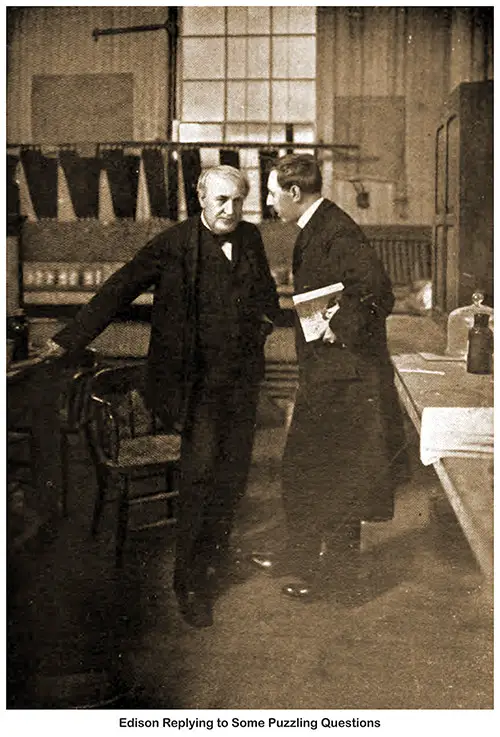
Edison Replying to Some Puzzling Questions. Thomas Alva Edison, 1908, p. 194. GGA Image ID # 1c3d74b970
He had good reason to have a feeling of security; for it is said that before leaving Newark, he had at one time forty-five distinct inventions in varying stages of completion, and, that the profit arising from their sale amounted to four hundred thousand dollars.
His most important achievement at Newark was the perfecting of the quadruplex telegraph, by means of which not only two but four messages could be sent over one wire at the same instant.
Besides this, so many minor inventions were completed that Edison was· called "The young man who keeps the path to the Patent Office hot with his footsteps."
The Wizard of Menlo Park
It is probable that when Edison opened his laboratory at Newark he felt that it would be some time before he outgrew that. In 1876, however, his work as an inventor had developed so wonderfully that he decided to give up manufacturing and devote his time wholly to inventing.
He needed a more extensive laboratory, one situated in a place so out of the way of public travel that he would not have many visitors.
For the site of his new laboratory, he chose Menlo Park. The name has since come to be so closely associated with Edison that when we hear it mentioned we think of the phonograph, the telephone, the electric light, and all of the great inventions which were worked out there.
It was a quiet spot, about an hour's ride by railroad from New York city, where the inventor was frequently called on business. Here in an open expanse Edison had a modest dwelling and a vast laboratory erected.
This laboratory, a plain white frame structure was far from being a handsome building. Its owner's only wish was to have it spacious, well lighted and convenient. He spared no cost in fitting it up with the most improved mechanical apparatus for experimenting. He had a powerful engine to supply the force needed.
The workshop, a room one hundred feet long, was enough to delight the heart of a lover of fine machinery. There were great whirring, buzzing wheels, endless belts of strongest leather, beautifully finished lathes, milling machines, drills, and planers.
There were all sorts of electrical machinery, splendidly made and kept bright and shining. But there were no electric lights and no telephone in the great laboratory unless, perhaps, in the mind of the inventor.
Upstairs was a chemical laboratory, a laboratory far beyond the brightest dreams of the newsboy on the Grand Trunk Railroad. Its walls were lined with shelves laden with rows of mysterious jars and bottles. The inventor made it a rule to keep at hand some of every chemical substance known. There were blowpipes, retorts, test tubes, and flasks without number.
Besides these rooms, there was a library. It was a large one well filled with standard and modern scientific works.
There was a small band of well-organized workers at Menlo Park. It included skilled mechanics, with a director at their head; scientific experimenters; with a scholarly professor at their head; a mathematician, a private secretary, and even a bookkeeper.
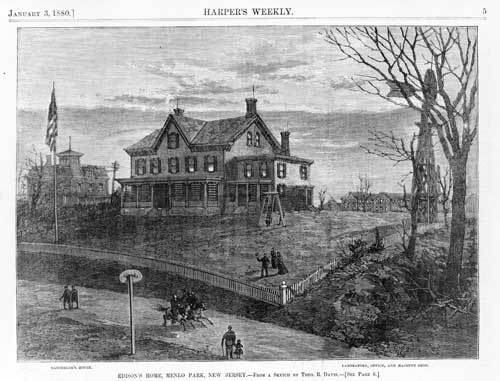
Thomas Edision's Home in Menlo Park
Guiding and controlling all, was Edison, the wonder worker, who could catch the lightning and hold if imprisoned in tiny glass globes, who could make it possible for one man to hear another talking hundreds of miles away, who could measure the heat of the stars, who could make a machine that would talk and sing and laugh like a human voice.
This man of almost magical powers, who worked at all hours of the night in the lonely laboratory, whence the sound of explosions and flashes of light more brilliant than sunlight, often issued, began to be regarded almost with a feeling of awe. People called him the "Wizard of Menlo Park.”
To those who worked with Mr. Edison, there was nothing awe-inspiring about him. He was not in the least spoiled by his success. He respected all parts of the work to which he had given his devotion, and the man who did the humblest portion of it well, was esteemed by him.
He was not afraid of hard work himself, and although he had competent men to manage the business for him, always took an active part in the affairs of the shop.
He went about in. rusty work clothes stained with acids, and with hands discolored and scarred, inspecting everything, and lending a hand where things were not going just as he wished. Menlo Park was no place for a man who did not love his work so much that he could forget his personal appearance and comfort while busy.
On one occasion, a new man refused to perform a task, which Mr. Edison had directed him to do. He said that he had not accepted the position with a view of becoming a manual laborer.
Mr. Edison with extreme courtesy begged his pardon, for having made an unreasonable request, and then did the work himself. That made the young man feel uncomfortable, but it taught him the lesson which all of Mr. Edison's employees had to learn sooner or later-the lesson of self-forgetfulness in work.
In the management of his business, Mr. Edison had conformed in many ways to ordinary business methods. But hours at Menlo Park were almost as irregular as at Newark.
The inventor could not get over the belief that the man who never got so interested in his work that he failed to hear the twelve o'clock whistle at noon, or the six o'clock whistle at night, was a poor sort of fel1ow. For his own part, he had not outgrown his independence of the clock.
As the years passed, the· inventor's mind lost nothing of its youthful activity. He found it easy to keep everyone in the big laboratory busy working out his ideas.
Whenever he thought of a possible improvement in one of his own inventions, or in a contrivance made by someone else, he made a note of it in a thick blank book. When one piece of work was finished this book always suggested innumerable ideas for further undertakings.
Sometimes Edison's inventions were pushed forward with amazing rapidity. An idea would occur to him in the morning. His draughtsmen would draw up the plans for it, and the workmen would make it in a single day.
He tells an incident to show how quickly he was able to transact patent business, not only at Washington, but in London. He made a discovery at four in the afternoon, telegraphed to his solicitor, and had him draw up the necessary specifications at once.
Then he cabled to London, an application for a patent, and before he arose next morning received word that his application had been filed in the English patent office. To understand this speedy transaction, we must remember that while it was early morning at Menlo Park it would be noonday at London.
Some of His Great Inventions
While numerous small inventions were thought of, made, and patented in an almost incredibly short space of time, you must not think that Edison never had any hindrances or difficulties. There were inventions on which he and his assistants labored for years, spending tens of thousands of dollars before reaching satisfactory results.
It would take too long to name all of Edison's inventions, and it would be impossible to describe them all. There are very few departments of electrical invention to which he has not contributed something.
The electric railroad and the automobile have received a share of his thought. His telephone; the megaphone, which carries the sound of the voice great distances without the help of wires; the quadruplex telegraph; the tasimeter, which measures the heat of the stars; or the kinescope, -- any one of them would have made the inventor famous. But he is perhaps best known by the invention of the incandescent electric light and the phonograph.
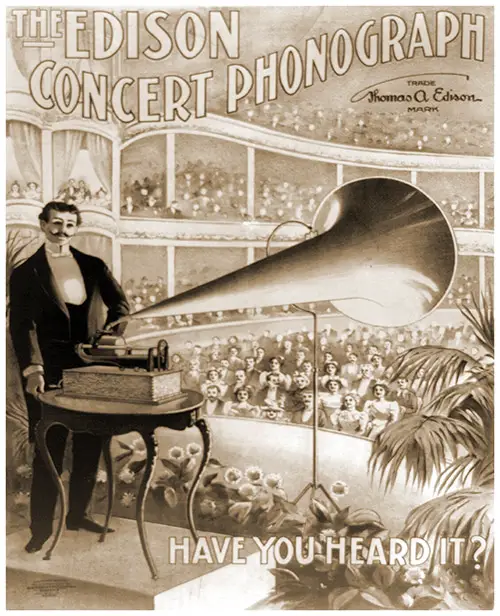
The Edison Concert Phonograph Have You Heard It? Advertising Poster for Edison Phonographs Showing a Man Playing a Phonograph on a Stage Before a Large Audience Seated in a Grand Concert Hall. The U.S. Printing Co., 1899. Library of Congress LC 99472463. GGA Image ID # 1c3aca1225
Every American boy and girl has Edison's name closely associated with the brilliant little globes of light, which are seen by thousands along city streets, in churches, in theaters, in public halls, and even in private dwellings.
A traveler in far off Egypt asked an ignorant donkey boy if he had ever heard of the President of the United States. He had not. He next asked if he had ever heard of Edison. With a nod of intelligence, the boy pointed to the electric light before the door of the hotel for answer.
Edison once said that the electric light had cost him more time, anxiety, and expense than any other invention. It was, however, the invention, which made him independently rich.
The principle of the light is simple. When an electric current passes from a good conductor to a poor one it causes heat. That a bright light might be obtained by non-conducting substances heated in this way, had been known for many years, but no one before Edison was able to turn the knowledge to practical use.
Even Edison found it extremely difficult to make an inexpensive, durable, and strong light. The greatest difficulty was to find a non-conducting filament strong enough to endure, and slight enough to be heated to a white glow with a moderate charge of electricity.
Those will never forget it, who were present at Menlo Park when the search for the filament was begun. Experiment after experiment failed, while the "wizard," growing only more wide awake and resolute, begged his associates, "Let us make one before we sleep.”
Expeditions were made to Japan, India, Africa, and South America in search of the best possible material for the filament.
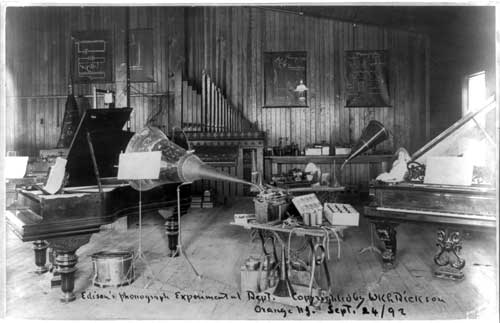
Edisons Phonograph - Experimental Dept - Orange NJ - 1892-09-24
Men were unwilling to believe that the incandescent electric light could be used extensively for illuminating purposes. But in the winter of 1880, a public exhibit of the new invention was given at Menlo Park.
The streets and trees were brilliantly lighted, and the laboratory was aglow inside and out with the dazzling white lights. Special trains were run to Menlo Park. Hundreds of people went to see the novel spectacle and all who saw were convinced that the incandescent light was a success.
The phonograph, while not so familiar to us as the electric light, arouses our wonder even more. You have perhaps heard that sound is made by vibrations of air. You have shouted in a bare room and heard the echo of your words come back with startling distinctness.
The wall received the vibrations and sent back other vibrations making similar but somewhat blurred sounds. This repetition of the vibrations to get a repetition of sound is the principle on which the phonograph is based.
Edison gives an interesting account of the dawning of the idea in his mind: He says: "I was singing to the mouthpiece of a telephone, when the vibrations of the voice sent the fine steel point into my finger.
That set me to thinking. If I could record the actions of the point and send the point over the same surface afterward, I saw no reason why the thing would not talk.
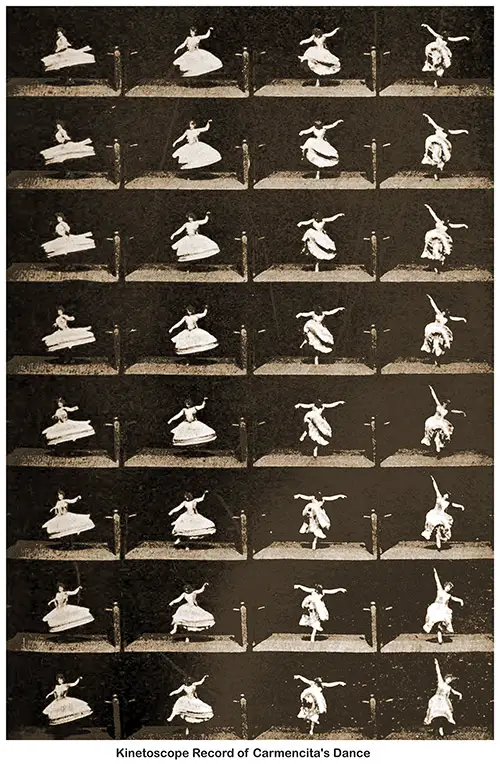
One of Edison's Kinetoscope Records of the Dance by Spanish Dancer Carmencita Was Made in 1887. The Edison Peep Show Machine Was Christened the Kinetoscope, and the Camera Wherewith the Pictures Were Made Was the Kinetograph. The Kinetoscope Was a Simple Mechanism Operated by a Battery-Impelled Electric Motor. The Film, Approximately Fifty Feet in Length, Was Run Between Electric Light and a Rapidly Revolving Shutter, Exposing the Picture by Flashes to the Viewing Lens Into Which the Spectator Peered. The Film Was Wound in an Endless Loop Over a Series of Small Rollers Known as a Spool Bank. In the Peep Show Machine, the Film Ran Continuously. Thomas Alva Edison, 1908, p. 168. GGA Image ID # 1c3cfaea0c
I tried the experiment first on a strip of telegraph paper, and found that the point made an alphabet. I shouted the words ‘Halloo! Halloo!' into the mouthpiece, ran the paper back over the steel point, and heard a faint ‘Halloo! Halloo!' in return. I determined to make a machine that would work accurately, and gave my assistants instructions, telling them what I had discovered."
A New Laboratory in Orange, New Jersey
In 1886, a new laboratory was built at Orange, New Jersey. This laboratory is so large that it makes its famous predecessor at Menlo Park seem small and insignificant, by comparison.
The equipment is complete for carrying on all sorts of experiments from those relating to the kinetograph to those in connection with the magnetic-ore separator.
In building his laboratory the inventor remembered to provide in many ways for the comfort and pleasure of the men whom he employed. At the top of the building, there is a large lecture hall. There the men often assemble to listen to scientific lectures given by the best scholars and lecturers in the country.
The library, with its wealth of books, is an attractive room. Mr. Edison cares little for luxury or ease, and this room was at first as plain as the rest of the building.
But on his forty-second birthday his men surprised him by introducing into his library some of the comforts he never thought of providing for himself. Rugs, easy chairs, tables, pictures, even plants were used to give the room an air of comfort and beauty.
In this room the inventor sometimes sits, not reading at his ease, but surrounded by great stacks of books on some particular subject, glancing eagerly through one volume after another as if his life depended on his mastering their contents within a given time.
He respects books as the record of the labor of other students and scientists. But he is often disappointed in them; he says, "Some way I never find just what I want in books."
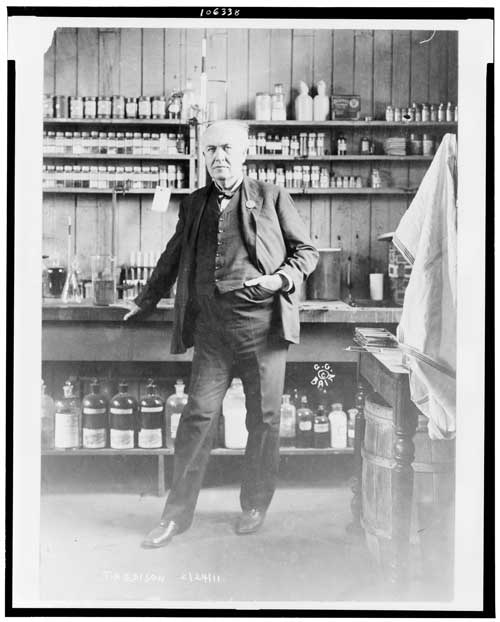
Thomas A. Edison In His Laboratory - c1911
During his early manhood, Edison contributed little in person to the social side of life. He believed that in his inventions he gave to the world the best part of himself. Society accepted the inventions but was not satisfied. Men insist on considering a man greater than any machine he may make.
Everything Edison did only made people more anxious to see and know him. For a long time he rebuffed all efforts of the public to make a hero of him.
When an attempt was made to give a dinner in honor of the great inventor he refused to be present saying: "One hundred thousand dollars would not tempt me to sit through two hours of personal glorification."
Efforts have been made to induce him to talk into one of his phonographs. But he refuses emphatically, declaring, “it would make me sick with disgust to see on every corner, 'Put a nickel in the slot and hear Edison talk.' "
He has not worked in order that he may at one time live without work. He says that his highest pleasure is in work and he looks forward to no season of rest. Although he is so devoted to his work, Edison's life is not void of brightness. He is one of the most joyous men in the world.
Failures and disappointments, he has accepted through life as philosophically as he did the destruction of his first laboratory by the angry railroad conductor.
He has the rare ability of transferring his attention quickly from one thing to another. When exhausted with work, he will dash out of his office, tell a funny story, have a good laugh with a friend, and in five minutes be as hard at work as ever.
He keeps an organ in his library on which he has taught himself to play a few of his favorite airs, and this often affords him a few minutes' refreshment in the midst of hours of close study.
His work never loses its charm; he is always engaged in some novel and interesting experiment. Within the last few years, however, he has admitted some pleasures into his life not directly connected with his work.
Mr. Edison has traveled extensively in America and in Europe and been received with high honors everywhere. His first wife having died, he married again, and bought a beautiful and luxurious home in Llewellyn Park, near Orange, New Jersey.
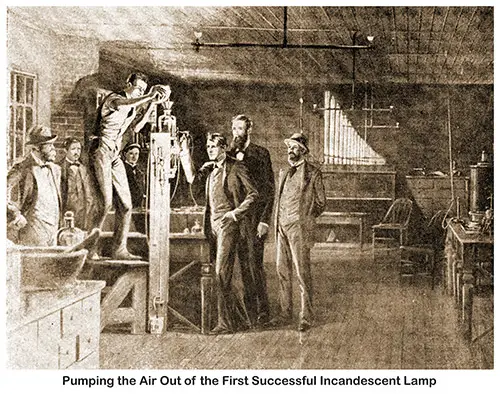
Pumping the Air Out of the First Successful Incandescent Lamp. Highlights in the Life of Thomas A. Edison, 1947. GGA Image ID #
News of Edison's invention of incandescent light created a sensation. After its announcement in the New York Herald on December 21, 1879, gave over an entire page to a description of the lamp and the electrical system for its use, stock in the Edison Electric Company had a spectacular rise. A public exhibition of the new light was arranged for New Year's Eve, 1879, and 3000 people made the excursion to Menlo Park to witness the miracle. There the eager throngs saw streets lighted, several houses illuminated and lamps burning in and around the Edison buildings.
A Partial List of Edison's Honors Degrees
- 1878–Honorary Ph.D. Union College
- 1879—Honorary Ph.D. Rutgers
- 1914—Honorary LL.D., N.Y.U.
- 1915—Honorary D.Sc., Princeton
- 1922—Honorary D.Sc., Rutgers
- 1930—Honorary D.Sc., Rollins College
- 1931—Honorary LL.D., Mount Union College
Medals Awarded to Thomas Edison
- 1878—Bronze medal of the American Institute. Awarded to Thomas Alva Edison for Duplicating Ink.
- 1878—Gold medal of the Exposition Universelle International de 1878, Paris.
- 1878—Gold Medal for his Telephone Transmitter — Thirteenth Exhibition of the Massachusetts Charitable Mechanic Association.
- 1878—French Legion of Honour -Chevalier.
- 1880—Silver Medal of the Melbourne International Exhibition awarded Thomas A. Edison for his Electric Pen.
- 1881—French Legion of Honour - Officer.
- 1882—Gold Medal of the Crystal Palace International Exposition, 1882 to T. A. Edison for a complete lighting system and other exhibits.
- 1887–Gold Medal -Societa Italiana Delle Scienze Premio Matteucci.
- 1889—French Legion of Honour - Commandeur.
- 1889—King Hubert of Italy made Edison a Grand Officer of the Crown of Italy.
- 1892—Silver Medal of Crystal Palace Electrical Exposition, 1892.
- 1895—Benjamin Count Rumford (1753-1814) Gold Medal for Discoveries in light and heat.
- 1904—Gold Medal - Louisiana Purchase Exposition St. Louis, 1904
- 1909—Claes Adolf Adelskold, 1907 for the invention of the Phonograph and Incandescent Lamp. Awarded by the Royal Academy of Sciences in Sweden.
- 1913—Emil Rathenau Gold Medal (1908) presented through the Society of National Safety for Electric Mine Safety Lamp.
- 1915—The Franklin Medal Award. The Franklin Institute of the State of Pennsylvania.
- 1918—(Circa) United States of America - Navy - For Distinguished Service.
- 1928—Gold Medal of the Society of Arts and Sciences.
- 1928—Congressional Medal. " He Illuminated the Path of Progress by his Inventions ."
- 1929—Gold Medal of Argentine.
- 1929—Grand Prize and Gold Medal of the Italian Academy of Sciences and Letters, Geneva,
- 1931—Pope Pius XI ( Gold ).Pius XI Pont. Max .-- An IX A, Civitate Vaticana Condita Anno 1.
- 1931—Albert Medal - Gold. Awarded to Edison by the Royal Society of Arts, Manufactures and Commerce
Bibliography
The Story of Thomas Edison from Frances M. Perry, “The Story of Thomas A. Edison" In Four American Inventors: A Book for Young Americans, New York, Cincinnati, and Chicago: American Book Company, 1901.
Frances M. Perry, “The Story of Thomas A. Edison: The Early Years.” In Four American Inventors: A Book for Young Americans, New York, Cincinnati, and Chicago: American Book Company, 1901, Pages 205-208
Frances M. Perry, “The Story of Thomas A. Edison: Youthful Busines Ventures.” In Four American Inventors: A Book for Young Americans, New York, Cincinnati, and Chicago: American Book Company, 1901, Pages 209-215
Frances M. Perry, “The Story of Thomas A. Edison: Study.” In Four American Inventors: A Book for Young Americans, New York, Cincinnati, and Chicago: American Book Company, 1901, Pages 216-220
Frances M. Perry, “The Story of Thomas A. Edison: The Boy Telegraph Operator.” In Four American Inventors: A Book for Young Americans, New York, Cincinnati, and Chicago: American Book Company, 1901, Pages 224-228.
Frances M. Perry, “The Story of Thomas A. Edison: A Change of Business.” In Four American Inventors: A Book for Young Americans, New York, Cincinnati, and Chicago: American Book Company, 1901, Pages 220-224
Frances M. Perry, “The Story of Thomas A. Edison: Telegrapher and Inventor.” In Four American Inventors: A Book for Young Americans, New York, Cincinnati, and Chicago: American Book Company, 1901, Pages 229-233.
Frances M. Perry, “The Story of Thomas A. Edison: In Boston.” In Four American Inventors: A Book for Young Americans, New York, Cincinnati, and Chicago: American Book Company, 1901, Pages 233-237.
Frances M. Perry, “The Story of Thomas A. Edison: Recognized As an Electrician.” In Four American Inventors: A Book for Young Americans, New York, Cincinnati, and Chicago: American Book Company, 1901, Pages 238-241.
Frances M. Perry, “The Story of Thomas A. Edison: Inventor and Manufacturer.” In Four American Inventors: A Book for Young Americans, New York, Cincinnati, and Chicago: American Book Company, 1901, Pages 241-245.
Frances M. Perry, “The Story of Thomas A. Edison: The Wizard of Menlo Park.” In Four American Inventors: A Book for Young Americans, New York, Cincinnati, and Chicago: American Book Company, 1901, Pages 245-251.
Frances M. Perry, “The Story of Thomas A. Edison: Inventions.” In Four American Inventors: A Book for Young Americans, New York, Cincinnati, and Chicago: American Book Company, 1901, Pages 251-255.
Frances M. Perry, “The Story of Thomas A. Edison: At Orange, New Jersey.” In Four American Inventors: A Book for Young Americans, New York, Cincinnati, and Chicago: American Book Company, 1901, Pages 256-260.
Frances Aurthur Jones, Thomas Alva Edison: Sixty Years of an Inventor's Life, New York, Thomas Y. Crowell & Company, Publishers, 1907/1908.
Cyril Arthur Player, Highlights in the Life of Thomas A. Edison, Detroit: The Detroit Edison Company, 1947.
A. and W. K. L. Dickson, The Life and Inventions of Edison, Fourth Paper," in Cassier's Magazine, Vol. III, No. 16, February 1893, pp. 283-297.
